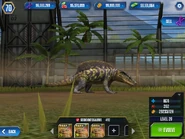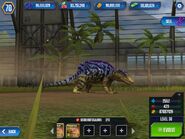(Editing a gallery) Tag: gallery |
|||
| (20 intermediate revisions by 12 users not shown) | |||
| Line 3: | Line 3: | ||
|meaning = cutting-tooth lizard |
|meaning = cutting-tooth lizard |
||
|diet = Carnivore |
|diet = Carnivore |
||
| − | |length = 2 to 2.7 |
+ | |length = 2 to 2.7 meters (6 to 9 feet) |
| − | |weight = 110 kilograms (250 |
+ | |weight = 110 kilograms (250 lbs) |
| − | |location = Texas |
+ | |location = Texas, USA |
|birth type = Egg |
|birth type = Egg |
||
| − | |game = ''[[Jurassic World: The Game]]'' |
+ | |game = ''[[Jurassic World: The Game]]''<br>''[[Jurassic World: Alive]]'' |
| ⚫ | }}'''''{{W|Secodontosaurus}}''''' (meaning "cutting-tooth lizard"), an extinct genus of "pelycosaur" synapsid that lived from between about 285 to 270 million years ago during the Early Permian. Like the well known ''[[Dimetrodon]]'', ''Secodontosaurus'' is a carnivorous member of the Eupelycosauria family Sphenacodontidae and has a similar tall dorsal sail. However, its skull is long, low, and narrow, with slender jaws that have teeth that are very similar in size and shape—unlike the shorter, deep skull of ''Dimetrodon'' ("two-measure tooth"), which has large, prominent canine-like teeth in front and smaller slicing teeth further back in its jaws. Its unusual long, narrow jaws suggest that ''Secodontosaurus'' may have been specialized for catching fish or for hunting prey that lived or hid in burrows or crevices. Although no complete skeletons are currently known, ''Secodontosaurus'' likely ranged from about 2 to 2.7 metres (7 to 9 ft) in length, weighing up to 110 kilograms (250 lb). |
||
| − | }} |
||
| ⚫ | '''''Secodontosaurus''''' (meaning "cutting-tooth lizard"), an extinct genus of "pelycosaur" synapsid that lived from between about 285 to 270 million years ago during the Early Permian. Like the well known ''[[Dimetrodon]]'', ''Secodontosaurus'' is a carnivorous member of the Eupelycosauria family Sphenacodontidae and has a similar tall dorsal sail. However, its skull is long, low, and narrow, with slender jaws that have teeth that are very similar in size and shape—unlike the shorter, deep skull of ''Dimetrodon'' ("two-measure tooth"), which has large, prominent canine-like teeth in front and smaller slicing teeth further back in its jaws. Its unusual long, narrow jaws suggest that ''Secodontosaurus'' may have been specialized for catching fish or for hunting prey that lived or hid in burrows or crevices. Although no complete skeletons are currently known, ''Secodontosaurus'' likely ranged from about 2 to 2.7 metres (7 to 9 ft) in length, weighing up to 110 kilograms (250 lb). |
||
Fossils of ''Secodontosaurus'' have been found in Texas in North America in the Wichita and the Clear Fork groups of Early Permian formations. In recent years, teams from the Houston Museum of Natural Science have recovered remains in the Clear Fork Red Beds of North Texas that appear to be new specimens of ''Secodontosaurus''. These discoveries are mentioned in online blogs but so far have not been formally described. |
Fossils of ''Secodontosaurus'' have been found in Texas in North America in the Wichita and the Clear Fork groups of Early Permian formations. In recent years, teams from the Houston Museum of Natural Science have recovered remains in the Clear Fork Red Beds of North Texas that appear to be new specimens of ''Secodontosaurus''. These discoveries are mentioned in online blogs but so far have not been formally described. |
||
The name ''Secodontosaurus'' comes from Latin ''seco'' "to cut" + Greek ''odous'' (''odont''-) "tooth" + Greek ''sauros'' "lizard" and is based on the anatomical term "secodont" for teeth with cutting edges designed to tear or slice flesh. Paleontologist Robert Bakker has dubbed ''Secodontosaurus'' the "fox-faced finback" after its long jaws. |
The name ''Secodontosaurus'' comes from Latin ''seco'' "to cut" + Greek ''odous'' (''odont''-) "tooth" + Greek ''sauros'' "lizard" and is based on the anatomical term "secodont" for teeth with cutting edges designed to tear or slice flesh. Paleontologist Robert Bakker has dubbed ''Secodontosaurus'' the "fox-faced finback" after its long jaws. |
||
| + | |||
{{Wikipediainfo}} |
{{Wikipediainfo}} |
||
| Line 31: | Line 31: | ||
12391947_10101781155761677_7050525710460490677_n.jpg|Level 32 Secodontosaur vs Level 20 ''[[Koolasaurus]]'' |
12391947_10101781155761677_7050525710460490677_n.jpg|Level 32 Secodontosaur vs Level 20 ''[[Koolasaurus]]'' |
||
Secodontosaurus (11).gif |
Secodontosaurus (11).gif |
||
| + | 13255900_179742919090304_1736849013871790232_n.jpg|Level 30 Secodontosaur vs Level 40 Secodontosaur |
||
| + | 13177168_184319641968457_6282133950380412715_n.jpg|Level 40 ''[[Indominus rex]]'' vs Level 33 ''Secodontosaurus'' |
||
</gallery> |
</gallery> |
||
| + | ===''[[Jurassic World: Alive]]''=== |
||
| + | ''see [[Secodontosaurus/JW: A]]'' |
||
| + | |||
| + | ''Secodontosaurus'' will be in ''[[Jurassic World: Alive]]''. |
||
| + | <gallery> |
||
| + | Screenshot_2018-04-22_at_12.25.22_AM.png |
||
| + | JW_Alive_Secodontosaurus.jpg |
||
| + | </gallery> |
||
| + | |||
| + | ==Navigation== |
||
| + | {{SpeciesNavBox}} |
||
[[Category:Synapsids]] |
[[Category:Synapsids]] |
||
| + | [[Category:Paleozoic animals]] |
||
| + | [[Category:Other Animals Discovered in the 1930s]] |
||
| + | [[Category:Jurassic World: Alive dinosaurs]] |
||
Revision as of 16:02, 25 April 2020
Secodontosaurus (meaning "cutting-tooth lizard"), an extinct genus of "pelycosaur" synapsid that lived from between about 285 to 270 million years ago during the Early Permian. Like the well known Dimetrodon, Secodontosaurus is a carnivorous member of the Eupelycosauria family Sphenacodontidae and has a similar tall dorsal sail. However, its skull is long, low, and narrow, with slender jaws that have teeth that are very similar in size and shape—unlike the shorter, deep skull of Dimetrodon ("two-measure tooth"), which has large, prominent canine-like teeth in front and smaller slicing teeth further back in its jaws. Its unusual long, narrow jaws suggest that Secodontosaurus may have been specialized for catching fish or for hunting prey that lived or hid in burrows or crevices. Although no complete skeletons are currently known, Secodontosaurus likely ranged from about 2 to 2.7 metres (7 to 9 ft) in length, weighing up to 110 kilograms (250 lb).
Fossils of Secodontosaurus have been found in Texas in North America in the Wichita and the Clear Fork groups of Early Permian formations. In recent years, teams from the Houston Museum of Natural Science have recovered remains in the Clear Fork Red Beds of North Texas that appear to be new specimens of Secodontosaurus. These discoveries are mentioned in online blogs but so far have not been formally described.
The name Secodontosaurus comes from Latin seco "to cut" + Greek odous (odont-) "tooth" + Greek sauros "lizard" and is based on the anatomical term "secodont" for teeth with cutting edges designed to tear or slice flesh. Paleontologist Robert Bakker has dubbed Secodontosaurus the "fox-faced finback" after its long jaws.
| Wikipedia has a more detailed and comprehensive article on Secodontosaurus |
Video Games
Jurassic World: The Game
Secodontosaurus is one of the dinosaurs in the game. It is a legendary tournament carnivore. It shares the Dimetrodon, Priotrodon and Ophiacodon model and animation.
Jurassic World: Alive
Secodontosaurus will be in Jurassic World: Alive.












